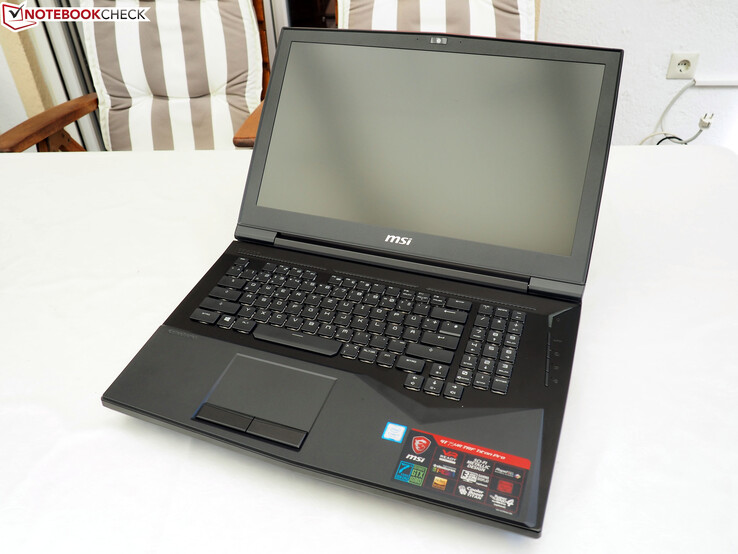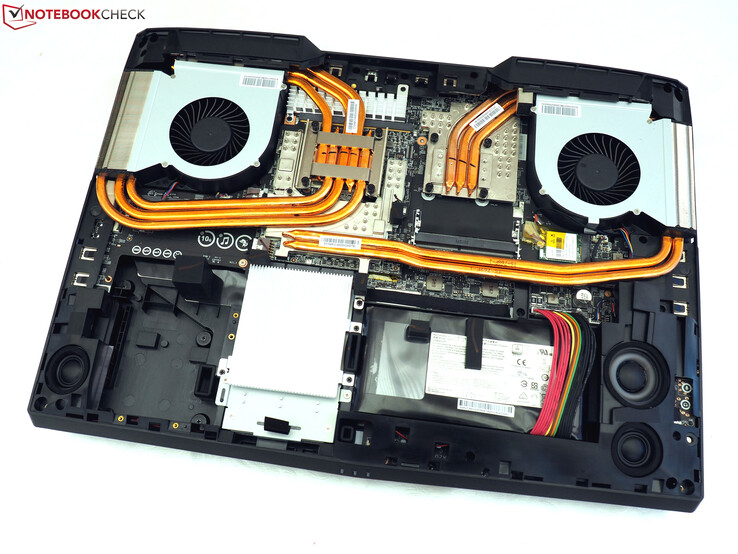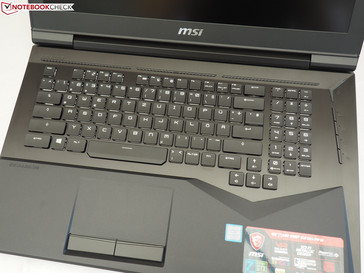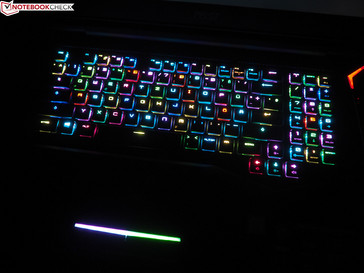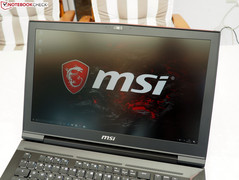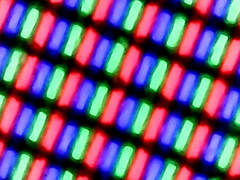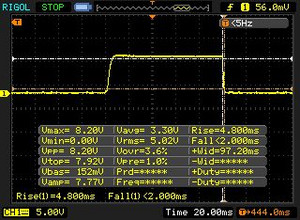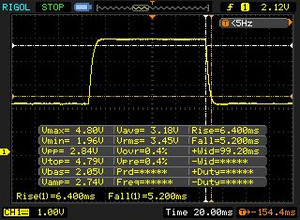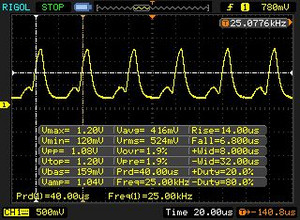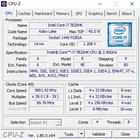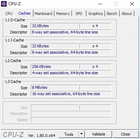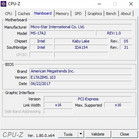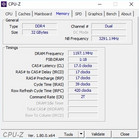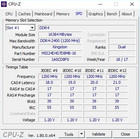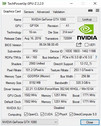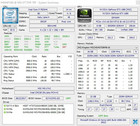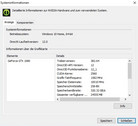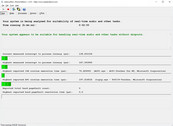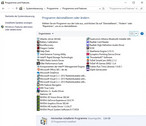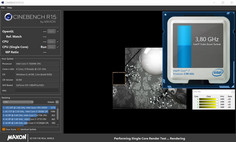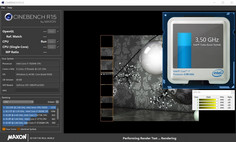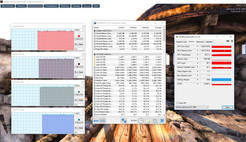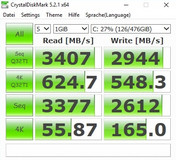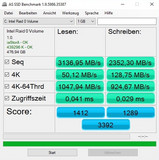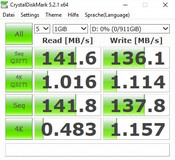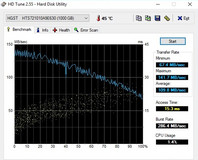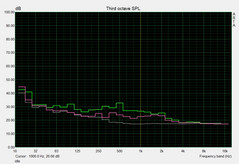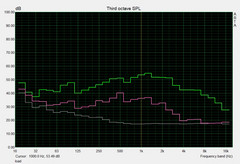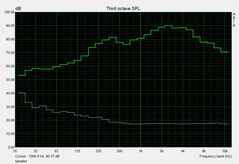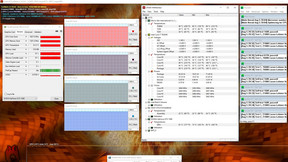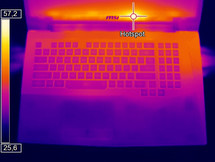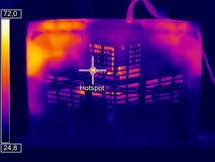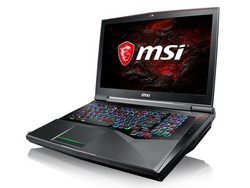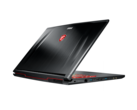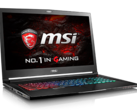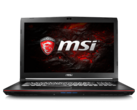MSI GT75VR 7RF Titan Pro (i7-7820HK, GTX 1080) Laptop Review

For the original German review, see here.
Buyers looking for a high-performance premium laptop will end up with MSI products sooner or later. While the GS line-up’s slim chassis is designed for mobile users and the GE lineup is aimed at price-conscious players, the GT laptops are made for the Core gaming community with a stationary playground that is out for pure performance. MSI's GT73VR that has been the 17-inch leader so far (Notebookcheck rating: 87%), is now replaced by the GT75VR that is tuned in many aspects.
The online shop Notebooksbilliger.de that kindly provided us with a review sample currently has the 17-inch scion in three versions. The 7RE-012 with 16 GB of DDR4 RAM, 120 Hz screen and a combination of a 256 GB SSD and 1 TB HDD for 2800 Euros (MSI GT75VR TITAN-083, (64 GB), $4315). Nvidia's GeForce GTX 1070 takes care of calculating graphics, while Intel's Core i7-7820HK CPU clocks inside.
The GT75VR 7RF-012 for 3600 Euros (MSI GT75VR TITAN PRO 4K-082, (64 GB), $4299) also with a Core i7-7820HK, but with more working memory (32 GB), more storage capacity (512 GB in RAID), and a much stronger GeForce GTX 1080 GPU is the basis for this article.
The 7RF-033 is the most expensive model. It does not offer more RAM or storage capacity or graphics power, but it boasts with a high-resolution 4K screen. Its price: exorbitant 4100 Euros (MSI GT75VR TITAN PRO 4K-082, (64 GB), $5965).
Besides the indirect GT73VR predecessor, rivals of the GT75VR are comparably priced and equipped high-end laptops such as Alienware's 17 R4, Acer's Predator 17 X, Asus' G701VIK, and Schenker's latest version of the XMG U727 that will all accompany us through this test.
Case
MSI sticks to its traditional design language for the casing's looks. The dark surfaces, some of which are brushed aluminum (lid, keyboard area), are adorned with red components that give the 17-inch machine a playful look. The wrist rest's material surprised us a bit. MSI has opted for a soft-touch finish, i.e. a rubber coating (just as sensitive as the other surfaces) here.
In terms of stability, at least the base unit scores well. The chassis can hardly be dented even with stronger pressure. The lid that produces noises when it is twisted is not as rigid. The hinges do a satisfactory job. Although the lid can be opened easily with one hand, the display does not rock excessively on unstable surfaces. As for the build, which is overall good, the transition between the base plate and base unit could be more precise.
One of the biggest shortcomings of the GT75VR is its extremely bulky appearance that looks outdated in the era of slim gamers, such as Gigabyte's Aero 15, Razer's Blade or MSI's own GS63VR. With a height of almost 6 cm (~2.4 in) and a weight of 4.6 kilograms (~10 lb), the 17-inch machine is one of the bulkiest and heaviest gaming laptops on the market.
Despite the same GPU, all rivals remain below 5 cm (~2 in). Asus' G701VIK and Alienware's 17 R4 are not even 4 cm (~1.6 in) tall. The enormous height has an impact on the ergonomics since the "keyboard" hand has to be lifted higher than the "mouse hand" and - depending on the seating and/or table height - is angled uncomfortably.
Connectivity
The connectivity proves to be - like the GT73VR - very generous. Five USB 3.0 Type A ports are just as impressive as four audio jacks (headphone incl. SPDIF, microphone, line-out, line-in). This is complemented by a card reader, RJ45 port, and a Kensington lock slot. Video materials are transmitted to external monitors via HDMI 2.0 (4K @60 Hz) or mini-DisplayPort. A Type-C port that supports USB 3.1 Gen.2, DisplayPort and Thunderbolt 3 rounds off the bundle and makes the GT75VR perfectly prepared for the future.
We liked the interface distribution because of it "tail-heaviness" although the rear ports are a bit awkward to reach due to the beveled upper edge. Also, both left and right handed users will get a share of the waste heat discharged from the lateral vents when playing games. In any case, we could feel how our mouse hand warmed up in the benchmark course.
SD Card Reader
We have to criticize the card reader's "downgrade". While the GT73VR almost completely exhausted our Toshiba reference card (max. 260 MB/s), the GT75VR only almost reaches the USB 3.0 standard. 88 MB/s in sequential read and 83 MB/s when transferring photos cannot compete with either Asus' G701VIK or Schenker's XMG U727, which exceed 200 and 100 MB/s. Only Acer's Predator 17 X has a comparably weak card reader.
| SD Card Reader | |
| average JPG Copy Test (av. of 3 runs) | |
| Asus G701VIK-BA049T (Toshiba Exceria Pro SDXC 64 GB UHS-II) | |
| MSI GT73VR 7RF-296 (Toshiba Exceria Pro SDXC 64 GB UHS-II) | |
| SCHENKER XMG U727 2017 (Toshiba Exceria Pro SDXC 64 GB UHS-II) | |
| MSI GT75VR 7RF-012 Titan Pro (Toshiba Exceria Pro SDXC 64 GB UHS-II) | |
| Acer Predator 17 X GX-792-76DL (Toshiba Exceria Pro SDXC 64 GB UHS-II) | |
| maximum AS SSD Seq Read Test (1GB) | |
| Asus G701VIK-BA049T (Toshiba Exceria Pro SDXC 64 GB UHS-II) | |
| MSI GT73VR 7RF-296 (Toshiba Exceria Pro SDXC 64 GB UHS-II) | |
| SCHENKER XMG U727 2017 (Toshiba Exceria Pro SDXC 64 GB UHS-II) | |
| Acer Predator 17 X GX-792-76DL (Toshiba Exceria Pro SDXC 64 GB UHS-II) | |
| MSI GT75VR 7RF-012 Titan Pro (Toshiba Exceria Pro SDXC 64 GB UHS-II) | |
Communication
The GT75VR can regain some ground with its wireless communication via the Killer Chip 1535 (Wi-Fi 802.11 a/b/g/n/ac, Bluetooth 4.2). Although 558 Mbit/s is just enough for one of the last places in the transmission test (1 meter/~3 ft away from the reference router), the reception performance of 700 Mbit/s is first-rate. Connection problems did not occur even when separated by several walls in practice. Tuning fans will also be happy with the Killer Control Center.
Accessories
The accessories are very limited if the buyer does not opt for one of the "Dragon Fever Bundles" (currently for the same price at Notebooksbilliger.de), which includes a backpack, headset, and other gimmicks. In addition to a quick start guide, only a recovery manual and a warranty booklet are in the box. The power supply is a 1.2 kg (~2.6 lb), 330-watt model that is extremely bulky with dimensions of 20 x 10 x 4.5 cm (~7.8 x ~4 x ~~1.8 in).
Maintenance
MSI has to be praised for the excellent maintenance and upgrade options. The manufacturer has designed the entire base plate as a service flap that is fairly easy to remove. A screwdriver (5 screws) and a bit of muscle power (clasps) then almost uncover the entire innards: the sound system, battery, wireless module, the cooling system that includes two fans, three heat pipes for the soldered CPU and - believe it or not - 7 (!) heat pipes for the removable GPU.
The storage devices are also underneath a cooling cover. To access the 2.5-inch slot, the M.2 SSDs have to be removed (2 slots with PCIe/NVMe support, 1 slot with SATA III support), which is quite inconvenient. The 4 RAM slots have been distributed on both sides of the motherboard. While the 32 GB (2x 16 GB SO-DIMM DDR4-2400) are underneath the keyboard and cannot be accessed without some effort, the empty banks are easy to reach.
In case the empty place in the bottom left of the screenshot is bewildering: The GT75VR is supposed to also be launched as an SLI variant with two GTX 1070 chips. Considering all things, the design is very similar to that of the GT73VR.
Software
As typical of MSI, diverse tools are preloaded on the system. The most important one is the so-called Dragon Center that serves as a central point with many features (see screenshots). Starting with a system monitor up to a tuning menu that not only offers a manual fan control, but also an overclocking option for both the CPU and GPU called Turbo.
Our Core i7-7820HK was overclocked to 4.0 GHz in the state of delivery. We used the shift mode "Power Options" for the measurements listed in the article (uses Windows settings). The fan speed was set to "Auto". The True Color tool is just as interesting since it optimizes the video output according to various scenarios (gamer, office, cinema, etc.). Since the preset "sRGB" mode presented the subjectively most natural image, we did not change it.
Warranty
A 24-month collect & return warranty is included. Please see our Guarantees, Return policies and Warranties FAQ for country-specific information.
Input Devices
Keyboard
One of the biggest unique selling points of the GT75VR is its first-rate keyboard. While the GT73VR still had a traditional keyboard, a mechanical model by SteelSeries is installed into the GT75VR. Unlike the GT83VR, it is not on the level of the touchpad, but is in the usual place. Compared with normal keyboards as found in 99% of all laptops, the typing feel is incomparably better. It is much crisper and more accurate, although the long drop and very loud (and cheap-sounding) typing noise needs some getting used to. The latter is a weakness of mechanical keyboards.
The unusual layout is one of the reasons why a "Very Good" is not achieved in this category. In addition to the strange and uneven separation of the F keys, some double assignments (e.g. F10/Print) and the differences to the standard layout annoyed us. For example, MSI moves "<>|" and "#" like in many of its gaming laptops, which results in a single-rowed enter in the German version. The Fn key is also displaced. Furthermore, a three rather than four rowed number pad is installed despite enough room. It is also too bad that the symbols of the four additional buttons on the keyboard's right are hardly legible.
The separated arrow keys that allow controlling volume and screen brightness and the pleasingly wide space bar are noticed favorably. An absolute highlight is the strong sRGB backlight that can be set for every key individually and - depending on the mode - ensures a real disco feeling. However, we find this rather embarrassing than stylish.
Touchpad
Unfortunately, the touchpad's quality is not as good as that of the keyboard. Although it offers a good accuracy and decent gesture support for several fingers (zoom, scroll, rotate, etc.), MSI has not done itself a favor with the rubberized surface. The soft-touch finish slows down gestures unnecessarily, especially when moisture is involved (wet or greasy fingers).
It is also unusual that the dedicated mouse keys do not respond over the entire surface but only toward the top. The same is true for the installed backlight that only illuminates the touchpad's lower edge. We would have preferred an "all-over" solution like in the GT73VR. The touchpad's color matches that of the wrist rest, and the only way to find it in the dark is using the fact that it is lowered. The touchpad's size is 11 x 6.5 cm (~4.3 x 2.6 in) - decent for 17-inch conditions.
Display
The 120 Hz panel has been adopted from the GT73VR. The N173HHE-G32 (CMN1747) is a Full HD screen based on TN technology. Apart from the middling viewing angles (typical TN problem) and mediocre brightness (average: 262 cd/m²), it does a good job. The low black level of 0.26 cd/m² results in a very high contrast (approx. 1050:1) that is on par with the competition.
| |||||||||||||||||||||||||
Brightness Distribution: 87 %
Center on Battery: 274 cd/m²
Contrast: 1054:1 (Black: 0.26 cd/m²)
ΔE Color 1.36 | 0.5-29.43 Ø5
ΔE Greyscale 0.64 | 0.57-98 Ø5.3
100% sRGB (Argyll 1.6.3 3D)
77% AdobeRGB 1998 (Argyll 1.6.3 3D)
86.8% AdobeRGB 1998 (Argyll 2.2.0 3D)
99.6% sRGB (Argyll 2.2.0 3D)
90.3% Display P3 (Argyll 2.2.0 3D)
Gamma: 2.19
| MSI GT75VR 7RF-012 Titan Pro CMN N173HHE-G32 (CMN1747), 1920x1080, 17.30 | MSI GT73VR 7RF-296 N173HHE-G32 (CMN1747), 1920x1080, 17.30 | Acer Predator 17 X GX-792-76DL LP173WF4-SPF5 (LGD056D), 1920x1080, 17.30 | Alienware 17 R4 2560x1440, 17.30 | Asus G701VIK-BA049T B173HAN01.1 (AUO119D), 1920x1080, 17.30 | SCHENKER XMG U727 2017 AU Optronics B173ZAN01.0 (AUO109B), 3840x2160, 17.30 | |
|---|---|---|---|---|---|---|
| Display | -1% | -24% | -26% | -21% | 4% | |
| Display P3 Coverage | 90.3 | 90.6 0% | 66 -27% | 61.2 -32% | 68.8 -24% | 86.6 -4% |
| sRGB Coverage | 99.6 | 99.9 0% | 83.7 -16% | 82.9 -17% | 87.7 -12% | 99.9 0% |
| AdobeRGB 1998 Coverage | 86.8 | 84.7 -2% | 61.2 -29% | 60.5 -30% | 64.1 -26% | 99.5 15% |
| Response Times | -64% | -300% | -124% | -211% | -296% | |
| Response Time Grey 50% / Grey 80% * | 11.6 ? | 26 ? -124% | 45 ? -288% | 30 ? -159% | 38 ? -228% | 44 ? -279% |
| Response Time Black / White * | 6.8 ? | 7 ? -3% | 28 ? -312% | 12.8 ? -88% | 20 ? -194% | 28 ? -312% |
| PWM Frequency | 25000 ? | |||||
| Screen | -235% | -83% | -122% | -82% | -40% | |
| Brightness middle | 274 | 307 12% | 380 39% | 402.3 47% | 306 12% | 362 32% |
| Brightness | 262 | 284 8% | 362 38% | 372 42% | 299 14% | 344 31% |
| Brightness Distribution | 87 | 85 -2% | 91 5% | 86 -1% | 91 5% | 85 -2% |
| Black Level * | 0.26 | 0.25 4% | 0.37 -42% | 0.62 -138% | 0.27 -4% | 0.35 -35% |
| Contrast | 1054 | 1228 17% | 1027 -3% | 649 -38% | 1133 7% | 1034 -2% |
| Colorchecker dE 2000 * | 1.36 | 9.65 -610% | 4.12 -203% | 5.6 -312% | 3.98 -193% | 2.46 -81% |
| Colorchecker dE 2000 max. * | 4.1 | 16.36 -299% | 8.19 -100% | 9.8 -139% | 7.29 -78% | 4.26 -4% |
| Greyscale dE 2000 * | 0.64 | 10.07 -1473% | 3.95 -517% | 4.7 -634% | 4.15 -548% | 2.9 -353% |
| Gamma | 2.19 100% | 2.12 104% | 2.47 89% | 2.14 103% | 2.45 90% | 2.31 95% |
| CCT | 6551 99% | 12145 54% | 6539 99% | 7519 86% | 7386 88% | 6120 106% |
| Color Space (Percent of AdobeRGB 1998) | 77 | 75 -3% | 55 -29% | 53.7 -30% | 58 -25% | 88 14% |
| Color Space (Percent of sRGB) | 100 | 100 0% | 84 -16% | 82.2 -18% | 89 -11% | 100 0% |
| Total Average (Program / Settings) | -100% /
-165% | -136% /
-100% | -91% /
-103% | -105% /
-87% | -111% /
-65% |
* ... smaller is better
The color accuracy sets standards. In the True Color mode sRGB, the DeltaE 2000 shift is an outstanding 0.64 (grayscales) and 1.36 (ColorChecker). We could not improve the rates via calibration as the screenshots below prove.
The color space is also beyond reproach. While most laptops achieve at most 80 to 90% sRGB, the GT75VR accomplishes an exemplary 100% so that even professional users who plan photo and video editing will be interested (77% AdobeRGB). Only the UHD panel in Schenker's XMG U727 achieves an even bigger color space in the comparison field (88% AdobeRGB).
Another plus point of the 120 Hz panel is its short response time. 6.8 ms when switching from black to white and 11.6 ms when switching from gray to gray belong to the best rates that we have ever measured. Alongside Nvidia's G-Sync technology and the strong GPU, games make an extremely smooth impression. However, the GeForce GTX 1080 is not completely exhausted with 1920x1080 pixels. The ideal would be 2560x1440 or 3840x2160 pixels.
Fortunately, the flickering that we discovered only occurs up to a screen brightness of 15% and, at 25 kHz, it is so high that even sensitive users should not perceive flickering. Very good: Backlight bleeding was not an issue of the review sample.
Display Response Times
| ↔ Response Time Black to White | ||
|---|---|---|
| 6.8 ms ... rise ↗ and fall ↘ combined | ↗ 4.8 ms rise | |
| ↘ 2 ms fall | ||
| The screen shows very fast response rates in our tests and should be very well suited for fast-paced gaming. In comparison, all tested devices range from 0.1 (minimum) to 240 (maximum) ms. » 15 % of all devices are better. This means that the measured response time is better than the average of all tested devices (21.5 ms). | ||
| ↔ Response Time 50% Grey to 80% Grey | ||
| 11.6 ms ... rise ↗ and fall ↘ combined | ↗ 6.4 ms rise | |
| ↘ 5.2 ms fall | ||
| The screen shows good response rates in our tests, but may be too slow for competitive gamers. In comparison, all tested devices range from 0.2 (minimum) to 636 (maximum) ms. » 20 % of all devices are better. This means that the measured response time is better than the average of all tested devices (33.7 ms). | ||
Screen Flickering / PWM (Pulse-Width Modulation)
| Screen flickering / PWM detected | 25000 Hz | ≤ 15 % brightness setting | |
The display backlight flickers at 25000 Hz (worst case, e.g., utilizing PWM) Flickering detected at a brightness setting of 15 % and below. There should be no flickering or PWM above this brightness setting. The frequency of 25000 Hz is quite high, so most users sensitive to PWM should not notice any flickering. In comparison: 53 % of all tested devices do not use PWM to dim the display. If PWM was detected, an average of 17900 (minimum: 5 - maximum: 3846000) Hz was measured. | |||
Performance
MSI's GT75VR is definitely situated in the premium range with its lightning-fast Kaby Lake processor and exorbitantly expensive top model from Nvidia's Pascal generation. 32 GB of DDR4 RAM and 1.5 TB of storage device capacity also point to a genuine desktop replacement that offers high future security.
Processor
MSI does not install the widely distributed and very popular Core i7-7700HQ with a clock speed of 2.8 to 3.8, but the 100 MHz faster Core i7-7820HK, which can boast with an 8 rather than a 6 MB L3 cache and a free multiplicator to justify the exorbitant price.
The performance of the quad-core model that can process up to eight threads simultaneously via Hyperthreading completely fulfills the expectations. A maximum of 3.9 GHz in single-core load and 3.5 GHz in multi-core load correspond to Intel's specifications. As our Cinebench loop confirms, the high clock speed is also maintained for a prolonged time. The results were very stable in the 30-minute test.
The GT75VR lags behind slightly in the benchmark chart because the other devices are tested with an enabled factory OC. Schenker's XMG U727 usually achieves the first place thanks to its desktop CPU. We could never get the 17-inch machine to throttle, i.e. drop below the base clock of 2.9 GHz. The cores even achieved 3.5 GHz in the stress test using the tools FurMark and Prime95 - a superb rate.
System Performance
The system performance is also beyond reproach. The high-end components and the SSD RAID ensure that the system runs quickly in every situation. The GT75VR settles between Asus' G701VIK and Alienware's 17 R4 in PCMark 8. Acer's Predator 17 X claims the first place, and Schenker's XMG U727 comes in last.
| PCMark 8 | |
| Home Score Accelerated v2 | |
| Acer Predator 17 X GX-792-76DL | |
| Asus G701VIK-BA049T | |
| MSI GT75VR 7RF-012 Titan Pro | |
| Alienware 17 R4 | |
| SCHENKER XMG U727 2017 | |
| Work Score Accelerated v2 | |
| Acer Predator 17 X GX-792-76DL | |
| Asus G701VIK-BA049T | |
| MSI GT75VR 7RF-012 Titan Pro | |
| Alienware 17 R4 | |
| SCHENKER XMG U727 2017 | |
| PCMark 10 - Score | |
| MSI GT75VR 7RF-012 Titan Pro | |
| PCMark 8 Home Score Accelerated v2 | 5237 points | |
| PCMark 8 Work Score Accelerated v2 | 5444 points | |
| PCMark 10 Score | 5211 points | |
Help | ||
Storage Devices
As appropriate for a modern gaming laptop, the GT75VR can use both a PCIe and NVMe technology for storage devices. MSI is not tight-fisted and combines two M.2 models to a RAID 0 array that adds up to a total of 512 GB. Both 256 GB Samsung drives from the SM961 lineup present a very good show.
Over 3000 MB/s in sequential read (AS SSD benchmark) and over 2000 MB/s in sequential write mark the absolute top. Single SSD solutions such as those in Acer's Predator 17 X, Alienware's 17 R4, and Schenker's XMG U727 cannot compete with this on paper. However, differences will hardly be noticed in most routine situations since current SSDs perform similarly with small files.
Should it get tight for the personal game and multimedia collection at some point, a 2.5-inch HDD with a capacity of 1 TB is also installed. HGST's Travelstar 7K1000 is an extremely successful 7200 model.
| MSI GT75VR 7RF-012 Titan Pro 2x Samsung SM961 MZVPW256HEGL NVMe (RAID 0) | MSI GT73VR 7RF-296 2x Samsung SM951 MZVPV256HDGL (RAID 0) | Acer Predator 17 X GX-792-76DL Toshiba NVMe THNSN5512GPU7 | Alienware 17 R4 SK Hynix PC300 NVMe 512 GB | Asus G701VIK-BA049T 2x Samsung SM961 MZVPW256HEGL NVMe (RAID 0) | SCHENKER XMG U727 2017 Samsung SM961 MZVPW256 m.2 PCI-e | |
|---|---|---|---|---|---|---|
| AS SSD | -4% | -23% | -38% | 9% | 6% | |
| Seq Read | 3137 | 2988 -5% | 2261 -28% | 1752 -44% | 3247 4% | 2746 -12% |
| Seq Write | 2352 | 2332 -1% | 1338 -43% | 735 -69% | 2520 7% | 1445 -39% |
| 4K Read | 50.1 | 46.75 -7% | 39.52 -21% | 35.61 -29% | 51 2% | 56.8 13% |
| 4K Write | 128.8 | 123.8 -4% | 133.8 4% | 113.4 -12% | 120.9 -6% | 175.9 37% |
| Score Read | 1412 | 1511 7% | 1118 -21% | 831 -41% | 1760 25% | 1858 32% |
| Score Write | 1289 | 1054 -18% | 930 -28% | 858 -33% | 1458 13% | 1187 -8% |
| Score Total | 3392 | 3310 -2% | 2581 -24% | 2072 -39% | 4088 21% | 3938 16% |
Graphics Card
MSI has omitted Nvidia's brand new Max-Q design in the GT75VR intentionally, allowing the GeForce GTX 1080 to show its full beauty. Thanks to the powerful cooling system, the DirectX 12 chip supported by a generous 8 GB of GDDR5X VRAM can use its clock potential extremely well. Almost 1810 MHz after 60 minutes of “The Witcher 3” speaks for itself. Even 1890 MHz was displayed for a moment in the render test of the GPU-Z test.
The stress test performance also impressed us. While the GeForce GTX 1080 tends to throttle significantly in other gaming laptops, the Pascal model in the GT75VR runs at approx. 1600 MHz during full load.
| 3DMark - 1920x1080 Fire Strike Graphics | |
| Asus G701VIK-BA049T | |
| Acer Predator 17 X GX-792-76DL | |
| Alienware 17 R4 | |
| SCHENKER XMG U727 2017 | |
| MSI GT75VR 7RF-012 Titan Pro | |
| MSI GT73VR 7RF-296 | |
| 3DMark 11 - 1280x720 Performance GPU | |
| Asus G701VIK-BA049T | |
| SCHENKER XMG U727 2017 | |
| MSI GT75VR 7RF-012 Titan Pro | |
| MSI GT73VR 7RF-296 | |
| Acer Predator 17 X GX-792-76DL | |
| Alienware 17 R4 | |
| Unigine Heaven 4.0 - Extreme Preset DX11 | |
| Asus G701VIK-BA049T | |
| SCHENKER XMG U727 2017 | |
| MSI GT75VR 7RF-012 Titan Pro | |
| MSI GT73VR 7RF-296 | |
The 17-inch machine is on par with the competition in the graphics benchmarks. In 3DMark 13's Fire Strike test, the five comparison devices drift at most 10% apart. It is a maximum of 6% in the Ungine Heaven 4.0 benchmark.
Note: The processor's graphics chip (Intel HD Graphics 630) remains inactive due to G-Sync. However, it is possible to save energy and reduce the other emissions in idle mode by switching the graphics accelerator via the GPU button. This requires rebooting the system (Nvidia's GPU was always active for our tests).
| 3DMark 11 Performance | 19621 points | |
| 3DMark Ice Storm Standard Score | 155671 points | |
| 3DMark Cloud Gate Standard Score | 29451 points | |
| 3DMark Fire Strike Score | 15851 points | |
| 3DMark Time Spy Score | 6563 points | |
Help | ||
Gaming Performance
Before dedicating ourselves to the gaming outcomes, we would like to say a few words about the long-term performance of the GeForce GTX 1080 that we simulated with “The Witcher 3”. The frame rates drop by 5 to 10% in the course of the 60-minute test only because the GPU's Turbo gets weaker as it reacts to increasing temperatures at some time. This behavior can be observed in almost every laptop and cannot be criticized.
There is generally no reason to worry about the frame rates in the Full HD sector. Although the 120 Hz technology is sometimes exhausted in maximum settings, the GeForce GTX 1080 achieves smooth rates even in demanding games such as “Ghost Recon Wildlands” or “Playerunknown's Battlegrounds”. The high-end GPU usually has enough power for 3840x2160 pixels, as the results in “Prey” and “Rocket League” prove. Core players will be absolutely satisfied with the GT75VR in any case.
The configuration with the GeForce GTX 1070 is right for saving a bit of money. Nvidia's second-best Pascal model also copes with 1920x1080 pixels quite well.
| low | med. | high | ultra | 4K | |
| The Witcher 3 (2015) | 144 | 75.9 | 52.2 | ||
| Ghost Recon Wildlands (2017) | 99.7 | 61.4 | 41.4 | ||
| Prey (2017) | 139 | 136 | 68.3 | ||
| Rocket League (2017) | 240 | 110 | |||
| Dirt 4 (2017) | 178 | 105 | |||
| Playerunknown's Battlegrounds (PUBG) (2017) | 115 | 90.1 | 32.8 |
Emissions
System Noise
The GT75VR loses most points for its high noise production. Unfortunately, 2 fans and 10 heat pipes cannot prevent the 17-inch machine from getting loud in 3D mode. While an average of 44 dB(A) in 3DMark 06 is still acceptable, 56 dB(A) in “The Witcher 3” and 62 dB(A) during full load are very annoying. Thus, games are no fun without a headphone. Other GTX 1080 laptops do a much better job here. Both the slimmer Alienware 17 R4 with a desktop CPU and Schenker's XMG U727 are quieter.
Perhaps not enough heat-conductive paste has been used or it is perhaps not distributed evenly since the Core i7-7829HK's temperature fluctuated by up to 15 °C (~59 °F) from one core to the other during the stress test. Here, the GPU is the center of annoyance. It gets even louder when the fan button is on as it boosts the noise development up to possibly record-breaking 64 dB(A).
The situation is not as tense in idle mode. Although the GT75VR reaches up to 38 dB(A) when booting, the laptop runs relatively quietly for gaming conditions (33 to 34 dB(A)). However, the fans are never completely inactive and tend to wobble. We also perceived a discreet coil whining sometimes.
Noise Level
| Idle |
| 33 / 34 / 38 dB(A) |
| Load |
| 44 / 62 dB(A) |
 | ||
30 dB silent 40 dB(A) audible 50 dB(A) loud |
||
min: | ||
| MSI GT75VR 7RF-012 Titan Pro i7-7820HK, GeForce GTX 1080 Mobile | MSI GT73VR 7RF-296 i7-7820HK, GeForce GTX 1080 Mobile | Acer Predator 17 X GX-792-76DL i7-7820HK, GeForce GTX 1080 Mobile | Alienware 17 R4 i7-7820HK, GeForce GTX 1080 Mobile | Asus G701VIK-BA049T i7-7820HK, GeForce GTX 1080 Mobile | SCHENKER XMG U727 2017 i7-7700K, GeForce GTX 1080 Mobile | |
|---|---|---|---|---|---|---|
| Noise | 3% | 5% | 2% | 4% | 5% | |
| off / environment * | 30 | 30 -0% | 30 -0% | 28.2 6% | 30 -0% | 30 -0% |
| Idle Minimum * | 33 | 34 -3% | 33 -0% | 35.6 -8% | 30 9% | 31 6% |
| Idle Average * | 34 | 35 -3% | 35 -3% | 35.6 -5% | 31 9% | 34 -0% |
| Idle Maximum * | 38 | 37 3% | 37 3% | 35.7 6% | 36 5% | 37 3% |
| Load Average * | 44 | 39 11% | 40 9% | 50.2 -14% | 47 -7% | 44 -0% |
| Witcher 3 ultra * | 56 | 50.2 10% | 51 9% | |||
| Load Maximum * | 62 | 56 10% | 50 19% | 50.2 19% | 56 10% | 52 16% |
* ... smaller is better
Temperature
The advantage of the aggressive fans is the casing's moderate temperature development. A maximum of 46 °C (~115 °F) in the upper back area and a maximum of 32 °C (~90 °F) in the wrist rest area are absolutely acceptable. It could only get critical on the underside, which exceeded 50 °C (~122 °F) in both “The Witcher 3” and the stress test. Thus, the laptop should generally not be used on the lap during gaming sessions.
The entire casing remained pleasantly cool at 28 to 35 °C (~82 to ~95 °F) in idle mode. The competing devices can only be compared conditionally due to the lower ambient temperatures (20 °C/~68 °F in the winter and spring vs. 24 °C/~75 °F in mid-summer). The common picture is seen under the hood. The GeForce GTX 1080 settled to an acceptable 81 °C (~178 °F) and the Core i7-7820HK to borderline 84 to 99 °C (~183 to 210 °F) after 60 minutes of full load - but without throttling as mentioned earlier.
(-) The maximum temperature on the upper side is 46 °C / 115 F, compared to the average of 40.4 °C / 105 F, ranging from 21.2 to 68.8 °C for the class Gaming.
(-) The bottom heats up to a maximum of 57 °C / 135 F, compared to the average of 43.2 °C / 110 F
(+) In idle usage, the average temperature for the upper side is 31.7 °C / 89 F, compared to the device average of 33.8 °C / 93 F.
(±) Playing The Witcher 3, the average temperature for the upper side is 37.8 °C / 100 F, compared to the device average of 33.8 °C / 93 F.
(+) The palmrests and touchpad are reaching skin temperature as a maximum (32 °C / 89.6 F) and are therefore not hot.
(-) The average temperature of the palmrest area of similar devices was 28.9 °C / 84 F (-3.1 °C / -5.6 F).
| MSI GT75VR 7RF-012 Titan Pro i7-7820HK, GeForce GTX 1080 Mobile | MSI GT73VR 7RF-296 i7-7820HK, GeForce GTX 1080 Mobile | Acer Predator 17 X GX-792-76DL i7-7820HK, GeForce GTX 1080 Mobile | Alienware 17 R4 i7-7820HK, GeForce GTX 1080 Mobile | Asus G701VIK-BA049T i7-7820HK, GeForce GTX 1080 Mobile | SCHENKER XMG U727 2017 i7-7700K, GeForce GTX 1080 Mobile | |
|---|---|---|---|---|---|---|
| Heat | 18% | 10% | 6% | 10% | 1% | |
| Maximum Upper Side * | 46 | 39.8 13% | 44.2 4% | 49.6 -8% | 50.9 -11% | 47.5 -3% |
| Maximum Bottom * | 57 | 47.8 16% | 43 25% | 56 2% | 44.6 22% | 56 2% |
| Idle Upper Side * | 34 | 27.1 20% | 32.4 5% | 29.6 13% | 29.9 12% | 34.5 -1% |
| Idle Bottom * | 35 | 27.4 22% | 32.8 6% | 29.2 17% | 28.8 18% | 33.6 4% |
* ... smaller is better
Speakers
Other laptop manufacturers can gladly take the sound quality of the GT75VR as an example. Although our audio analysis shows a bit of potential for improvement in bass and mids, the 17-inch machine has one of the best sound systems that we have ever encountered. Only very few laptops have such a powerful and balanced sound.
This is no surprise as MSI has invested a lot of resources in both the hardware (Dynaudio speakers, gold-plated plugs, amplifiers, digital-analog converters, etc.) and the software. In addition to the manufacturer's sound tool, a program called Nahimic 2+ is preloaded on the system. It provides diverse profiles and setting options. The GT75VR's high maximum volume is also impressive. Up to 98 dB(A) even fill large rooms with sound decently. Most gaming laptops achieve only 75 to 85 dB(A).
In a nutshell: Thanks to the superb sound, external speakers are not needed. The integrated 2.1 system is suitable for music, videos, and games to an equal degree (if the loud fans can be tolerated and a headset is not used).
MSI GT75VR 7RF-012 Titan Pro audio analysis
(+) | speakers can play relatively loud (98 dB)
Bass 100 - 315 Hz
(±) | reduced bass - on average 8.7% lower than median
(+) | bass is linear (4.9% delta to prev. frequency)
Mids 400 - 2000 Hz
(+) | balanced mids - only 3.6% away from median
(+) | mids are linear (4% delta to prev. frequency)
Highs 2 - 16 kHz
(±) | higher highs - on average 6% higher than median
(+) | highs are linear (3.4% delta to prev. frequency)
Overall 100 - 16.000 Hz
(+) | overall sound is linear (13.4% difference to median)
Compared to same class
» 17% of all tested devices in this class were better, 6% similar, 76% worse
» The best had a delta of 6%, average was 18%, worst was 132%
Compared to all devices tested
» 11% of all tested devices were better, 3% similar, 86% worse
» The best had a delta of 4%, average was 25%, worst was 134%
MSI GT73VR 7RF-296 audio analysis
(+) | speakers can play relatively loud (93 dB)
Bass 100 - 315 Hz
(±) | reduced bass - on average 11.7% lower than median
(±) | linearity of bass is average (9% delta to prev. frequency)
Mids 400 - 2000 Hz
(+) | balanced mids - only 3% away from median
(+) | mids are linear (3.6% delta to prev. frequency)
Highs 2 - 16 kHz
(+) | balanced highs - only 4% away from median
(+) | highs are linear (3.5% delta to prev. frequency)
Overall 100 - 16.000 Hz
(+) | overall sound is linear (13.6% difference to median)
Compared to same class
» 19% of all tested devices in this class were better, 6% similar, 75% worse
» The best had a delta of 6%, average was 18%, worst was 132%
Compared to all devices tested
» 11% of all tested devices were better, 3% similar, 85% worse
» The best had a delta of 4%, average was 25%, worst was 134%
Frequency diagram comparison (checkboxes above can be turned on/off!)
Energy Management
Power Consumption
The GT75VR has a relatively high power consumption when the GeForce GPU is active. Laptops with Nvidia's Optimus technology clearly undercut 34 to 50 watts in idle mode. However, most gamers consume less power, even without Optimus. We measured only 29 to 40 watts from the GT73VR in idle mode. The 17-inch machine gets really thirsty during load. Almost 257 watts in “The Witcher 3” are considerably more than in Alienware's 17 R4 that drains only 180 watts from the outlet despite an identical CPU and GPU.
The GT75VR is also less efficient during full load. At least MSI delivers the laptop with a sufficiently strong power supply. Schenker's XMG U727 sets the negative record. Due to the desktop CPU, the 3D rates are quite a bit higher than among the GTX 1080 competition.
| Off / Standby | |
| Idle | |
| Load |
|
| MSI GT75VR 7RF-012 Titan Pro i7-7820HK, GeForce GTX 1080 Mobile | MSI GT73VR 7RF-296 i7-7820HK, GeForce GTX 1080 Mobile | Acer Predator 17 X GX-792-76DL i7-7820HK, GeForce GTX 1080 Mobile | Alienware 17 R4 i7-7820HK, GeForce GTX 1080 Mobile | Asus G701VIK-BA049T i7-7820HK, GeForce GTX 1080 Mobile | SCHENKER XMG U727 2017 i7-7700K, GeForce GTX 1080 Mobile | |
|---|---|---|---|---|---|---|
| Power Consumption | 13% | 17% | 9% | 17% | -8% | |
| Idle Minimum * | 34 | 29 15% | 27 21% | 37.5 -10% | 24 29% | 32 6% |
| Idle Average * | 41 | 35 15% | 32 22% | 37.6 8% | 31 24% | 43 -5% |
| Idle Maximum * | 50 | 40 20% | 41 18% | 37.6 25% | 38 24% | 51 -2% |
| Load Average * | 106 | 94 11% | 102 4% | 122.4 -15% | 98 8% | 138 -30% |
| Witcher 3 ultra * | 257 | 180.3 30% | 279 -9% | |||
| Load Maximum * | 320 | 315 2% | 248 22% | 277.4 13% | 320 -0% | 350 -9% |
* ... smaller is better
Battery Runtime
Naturally, the high power consumption has an impact on the battery life. The GT75VR lasts for at most 3 hours, even with minimum brightness and low load (Battery Eater Reader's Test). Approximately 2.5 hours of Wi-Fi browsing and 2.5 hours of watching HD videos (medium brightness) are also modest. Acer's Predator 17 X and Asus' G701VIK, both with stronger batteries (89 and 93 Wh vs. 75 Wh) are first depleted after 3.5 to 4 hours. The GT75VR shut down after just 1 hour in Battery Eater's Classic test that simulates high load and which is performed using maximum brightness.
Furthermore, playing games without the power supply is not a good idea for performance reasons. The frame rate dropped by 70% (22 rather than 70 FPS @ FHD/Ultra) in the test with “The Witcher 3”.
| MSI GT75VR 7RF-012 Titan Pro i7-7820HK, GeForce GTX 1080 Mobile, 75 Wh | MSI GT73VR 7RF-296 i7-7820HK, GeForce GTX 1080 Mobile, 75.2 Wh | Acer Predator 17 X GX-792-76DL i7-7820HK, GeForce GTX 1080 Mobile, 88.8 Wh | Alienware 17 R4 i7-7820HK, GeForce GTX 1080 Mobile, 99 Wh | Asus G701VIK-BA049T i7-7820HK, GeForce GTX 1080 Mobile, 93 Wh | SCHENKER XMG U727 2017 i7-7700K, GeForce GTX 1080 Mobile, 89 Wh | |
|---|---|---|---|---|---|---|
| Battery Runtime | 5% | 56% | 28% | 61% | 29% | |
| Reader / Idle | 182 | 313 72% | 276 52% | 342 88% | 222 22% | |
| H.264 | 148 | 145 -2% | 204 38% | |||
| WiFi v1.3 | 144 | 160 11% | 251 74% | 181 26% | 241 67% | 168 17% |
| Load | 65 | 90 38% | 69 6% | 83 28% | 97 49% |
Verdict
Pros
Cons
All said, the GT75VR leaves a mixed impression. First the good: Compared with the GT73VR that we found good to very good over long parts, MSI has made improvements in several sections. Thus, not only the sound but also the keyboard reaps in a high rating.
Except for the unusual layout and the extremely prominent typing noise, the mechanical keyboard by SteelSeries is absolutely pleasing. After typing on a corresponding model, the user will never want to return to a traditional keyboard. The change feels just as revolutionary as when switching from an HDD to an SSD.
Other components that were already convincing in the GT73VR have been adopted without much modification. For example, the superb maintenance options (4x RAM, 4 storage devices, removable GPU, etc.), the generous connectivity including a Thunderbolt 3 port or the highly responsive and true color 120 Hz panel with G-Sync support.
Unfortunately, backslides that we do not always understand are seen in some areas. Why the touchpad has to be rubberized (the fingers quickly get stuck) is just as puzzling as the fans' extremely high noise level in 3D mode, which is even higher than from the GT73VR despite a thicker chassis and higher weight. Thus, noise-sensitive users should avoid the GT75VR. The same is true for users who are frequently on the go and do not want to always reboot for switching from Nvidia's to Intel's GPU for a useful battery life.
The 17-inch machine remains to be a pure desktop replacement that only looks good on the desk at home.
The ROG Zeyphrus GX501 by Asus, for example, proves that slimmer and quieter are possible (with limited performance). Buyers who do not have a problem with bulky casings can also opt for Acer Predator 17 X, Alienware 17 R4, Asus G701VIK or Schenker XMG U727 as equal alternatives. They also reaped in a similarly high rating in the test (85 to 88%). However, they do not feature a mechanical keyboard.
MSI GT75VR 7RF-012 Titan Pro
-
08/08/2017 v6(old)
Florian Glaser


 Deutsch
Deutsch English
English Español
Español Français
Français Italiano
Italiano Nederlands
Nederlands Polski
Polski Português
Português Русский
Русский Türkçe
Türkçe Svenska
Svenska Chinese
Chinese Magyar
Magyar